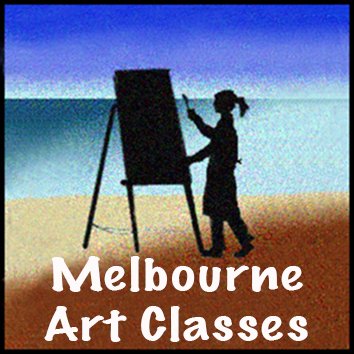ADULT GROUPS - MATERIALS REQUIRED
MATERIALS FOR THOSE MOVING ONTO OIL PAINTS
If you are enrolled with Melbourne Art Classes and are moving to oils, or if you are taking the course in Oil painting DIY. this information is available with the Online Oil painting course.
I usually recommend to all students first starting with painting (in any medium) not to buy any more than 6-8 (a specific 6-8) pigments, BUT not primarily because of the cost savings. The main reason is to facilitate colour theory comprehension and clever colour mixing. i.e.. it is easier to conjure up and plan harmonious relationships if you know which hues the colours are made up of and how to make them. (you can always add convenience colours later).
WE RECOMMEND BLOCKING IN YOUR PAINTING IN ACRYLICS, LETTING IT DRY, MAKING IT MATT BY SCRUBBING BACK A BIT OR PAINTING A LAYER OF MATT VARNISH OVER AND LETTING IT DRY. (even a slight sheen on the block-in layer can make adhesion of the oil layer a little less efficient).
If you want to learn in our contemporary two-part approach, get the same 6-8 pigments in both acrylics and oils. plus an acrylic matte varnish,
https://www.cavalierart.com.au/?s=Water+mixable+oils&post_type=product&product_cat=0
*** WINDSOR & NEWTON / ARTISAN WATER MISCIBLE OIL PAINTS - google for best-priced supplier near you, we recommend artshop.com.au currently
Cadmium Yellow Pale Hue , Permanent Alizarine, Ultramarine Blue, Burnt umber, Phthalo blue, Phthalo green (blue shade), titanium white, zinc white
We don’t recommend a pre-made ‘kit’ (kits don’t tend to have what we recommend. eg. the only red is usually cadmium or crimson (this can be made with your magenta/ Alizarine crimson and yellow (but not the other way around)
https://www.cavalierart.com.au/product/artisan-studio-set-10-37ml-tubes-linseed-oil-brushes/
ALSO GOOD - google for the best-priced supplier near you
***COBRA WATER MISCIBLE OIL PAINTS - Transparent Yellow Medium, Permanent Yellow Light, titanium white, Zinc white 150 ml, Ultramarine blue, Phthalo Blue, Burnt umber, Cobra Quick Dry Medium (For thin glazes)
Q. What other materials, solvents and mediums will you need to undertake oil painting? Actually, the answer to the question all depends on whether you are learning traditionally (eg. with turpentine, linseed oil, Damar varnish) OR blocking in with acrylic, giving a layer of matte varnish, then finishing the painting in water-miscible oils.SEE glazing medium options above
* PALETTE KNIVES (metal) are handy for mixing (smaller knives make less of a mess, and they help you use less paint) and can also be used to apply paint with. Buy a few different shapes and lengths
* A PAINT PALETTE (flat and larger is better, tear-off disposable ones are ok as well). The best palette for mixing oils is a glass one (put a neutral mid-tone grey paper under it, or paint the bottom grey. This helps with mixing your colours (some find a grey better than a white base, due to the values appearing relatively darker or lighter according to the value they are applied to.
* BRUSHES - Purchase a separate set of brushes from those you use for acrylics
* SOLVENT: (only for traditional oils)Mineral Turps can be used for cleaning brushes (but not for painting, we always use pure turps as a paint thinner and in the traditional medium mixes). Now, however, there are a few choices of odourless solvents (OMS or Turpenoid) and these are readily available in art shops now and much nicer to clean up with.
*2-3 GLASS JARS with lids, that will hold your odourless spirit (a decanting system is shown in our DIY Oil Painting course on for re-using the thinner).
BASIC SUBSTRATE MATERIALS FOR OIL PAINTING
* CANVAS / BOARDS to paint on, primed canvas boards are great for students, even canvas sheets/pads ( if designed for oils). It is helpful to do a lot of studies and learning projects without the expectation of hanging every piece. When you want to paint on stretched canvases, just know that the range of quality available is broad, buy what you can afford.
* EASEL (optional but handy), you can just rest small canvases against a table on your lap, or tilted on a book on the table, but it is great to be able to step back and view your work from time to time.
* OLD TOWELS for working with water-mixable oils CAN BE WASHED & reused
Also Handy - Drop cloth, painting clothes, and plastic/latex gloves(for the messy jobs)
* MEDIUM - The main medium to buy ( to learn the contemporary way ) is one of the glazing mediums, plus maybe impasto medium for oils if you want to go thicker sometimes. Winsor & newton have a fast-drying medium as well (although it may yellow the colours a little over time, as some other oils do as well.)
* If you really have an attachment to the idea of the slower traditional approach, buy some pure GUM turpentine and artist’s linseed oil or walnut oil to use in mixing your increasingly 'fat' mixtures of medium. (or some companies make a medium 1, 2 and 3 which are increasingly fatter pre-made medium mixtures.)
* PAPER TOWEL is better to use than rags for cleaning up if you don’t like the noxious odours surrounding oil paints and solvents, because the used rags carry most of the smell in the air later.

